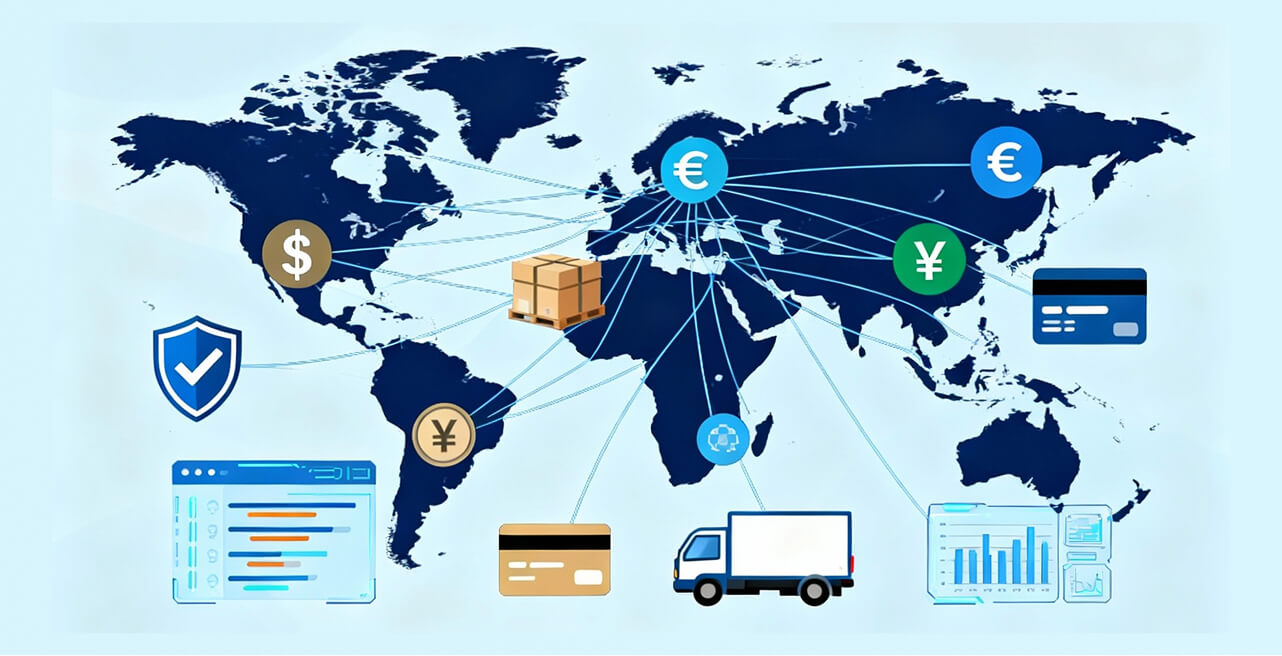Global e-commerce keeps accelerating. Worldwide online sales reached US $6.33 trillion in 2024, with momentum pointing to US $6.4 trillion for 2025. Meanwhile European e-commerce turnover is projected to hit €958 billion this year - the region’s first real, inflation-adjusted growth since 2021.
Growth is even sharper across ASEAN: Southeast Asia’s digital economy is on track for US $263 billion GMV in 2024, up 15 % year-on-year.
Yet toggling “ship internationally” is just the start.
Duties, currency conversion, returns and local expectations can derail expansion if you fly blind. In the next sections, we’ll map a proven route - from market selection to post-launch optimisation - to turn curious browsers into loyal cross-border customers.
What Is Cross-Border Ecommerce?
Cross-border e-commerce is any online sale where the shopper’s shipping address lies outside the merchant’s home country. Once a parcel crosses a national boundary, it picks up a new set of rules - import duties, product-safety certificates, data-privacy requirements - that domestic orders never see.
But for merchants, the paperwork is the real hurdle. Many brands sidestep weeks of bureaucracy by trading through an importer of record in each destination, shifting customs liability to a local expert while they stay focused on sales, service and stock.
How the flow works
- Shopper checks out in local language and currency.
- Payment gateway settles the local tender, converts funds for the merchant.
- Parcel rides on the commercial invoice, clears customs under its HS code, and duties are settled.
- A domestic carrier completes last-mile delivery - and, if needed, the return trip.
Pro Tip: Offer Delivered Duty Paid (DDP) shipping whenever margins allow; prepaid taxes lift conversion rates and all but eliminate “return-to-sender” surprises at the border.
Benefits of Cross-Border Ecommerce for Growing Brands
Crossing borders puts your catalogue in front of millions of new wallets - and the revenue delta is hard to ignore. Global sales routed through international checkouts are on pace to become a US $5.6 trillion opportunity by 2030 - growing twice as fast as domestic-only e-commerce.
Why does that matter to a scaling brand?
- Revenue lift: International buyers often build 15–20 % larger baskets, especially on niche or premium SKUs unavailable locally.
- Risk hedging: Diversifying sales across currencies cushions single-market downturns.
- Seasonality smoothing: Singles’ Day in ASEAN lands weeks before Europe’s Black Friday, letting you cycle inventory instead of stock-piling.
- Product validation: Launch a new flavour or limited edition in a trend-friendly market, gauge uptake, then scale globally.
- Brand equity: A presence in multiple countries signals credibility - useful when negotiating marketplace slots or retailer listings.
Domestic vs cross-border at a glance
Insider Tip: Shoppers will forgive shipping that takes a few days longer, but they hate surprise fees. So always display landed prices (DDP) at checkout.
When these levers work together - duties prepaid, payments truly local, parcels moving through regional hubs - cross-border stops feeling risky and starts functioning as a disciplined, data-driven growth engine.
And because many of the fastest-growing corridors sit squarely inside the 11 markets where we already stage inventory and clear customs, brands can capture upside quickly without reinventing their entire operating model.
Building Your Cross-Border Ecommerce Strategy: Quick Overview
Crossing into a new country is rarely a single to-do item. Payments, labels, and carriers all need to click into place at the same time.
We’ll cover a six-piece framework that keeps teams aligned, budgets predictable, and launch dates firm. You’ll see each step unpacked later, yet the chart below flags where attention - and budget - should land first.
Remember: Sequence beats speed, every time. A modest plan, executed in order, outclasses a brilliant plan executed chaotically.
Looking for more insights? Our recent breakdown of 8 proven expansion tactics pairs well with the checklist above.
With the roadmap set, let’s dive into Step 1 - choosing the markets most likely to reward your next profitable move.
Step 1: Pick the Right Market for Your First Cross-Border Launch
Choosing where to land first is the single biggest driver of payback time. Rather than chasing the hype, rank markets on demand, cost to serve, and regulatory friction.
In our work with fast-moving brands, launches succeed fastest when those forces align and logistics routes already exist.
Begin by mapping product-search volume against local price sensitivity. A surge in imports but flat domestic supply often signals white space your catalogue can fill. Overlay shipping cost and tax burden to understand landed price; high duty may erase margin, even if demand looks strong.
Demand signals
- Search intent via Google Market Finder
- Social chatter - TikTok/Instagram spikes often precede marketplace surges
- Marketplace “out-of-stock” counts - short supply hints at a gap you can fill
- Competitor ad spend - a jump in sponsored listings hints at profitable conversion
- Stock-out complaints on forums - unmet demand, you can solve
- Seasonality curves - supplement sales that dip in July across Western Europe may spike in India’s monsoon season
Buying-power metrics
- GDP per capita above €15 000 supports mid-premium pricing
- Card or wallet penetration over 60 % enables instant settlement
- Smartphone usage above 80 % correlates with impulse buys
- Import duty under 10 % keeps landed price competitive
Step 2: Compliance First - Certifications & Taxes in Ecommerce Cross-Border
Borders love paperwork. A single error on a certificate can delay a shipment that left Tallinn on Monday, leaving it stuck in a bonded zone three Fridays later.
Compliance is the single most expensive step to “fix later,” so it’s best to get it right from the start.
Start by ensuring you have the correct HS code - misclassification invites extra inspections on every shipment.
Verify whether destinations require safety dossiers (CPNP for cosmetics, sanitary registration for supplements, CE for electronics) and whether labels need to include local languages or country-of-origin details.
When it comes to taxes, incorporate import VAT and duties into a landed-cost calculator. Displaying a duty-paid total at checkout nearly eliminates “surprise-fee” refusals, improving both conversion rates and customer satisfaction.
When the compliance surface grows wide, many brands lean on an importer of record to assume liability and preserve working capital for growth initiatives.
Lastly, pre-clear high-volume SKUs. Some customs desks accept digital documents 24 hours before departure; matching paperwork lets parcels to be fast-tracked upon arrival, reducing lead times by days.
.webp)
Step 3: Payments & Currencies - Let Shoppers Pay Their Way
A checkout can look perfect yet still lose sales if the card logo feels unfamiliar or the final price shifts during foreign-exchange conversion. Local payment choice is conversion rocket fuel.
In India, UPI and Paytm drive close to half of online orders; in Estonia, card rails dominate; in Israel, digital wallets are closing the gap fast. Data shows that at least three dominant methods in every country across our footprint, so flexibility drives the extra conversion point.
Currency display is the next trust trigger. Listing prices in rupees, euros, or lari reassures buyers; hiding the FX math does the opposite. The simplest tactic is dual transparency: lock the cart in the shopper’s currency, then offer a small “see this in USD” toggle for reference.
Fraud & Chargebacks
Cross-border transactions light up new revenue streams, but they also widen the attack surface for fraudsters who know how to exploit currency swings and distance-based disputes.

Step 4: Fulfillment & Logistics - Moving Parcels Across Borders
Delivery is the moment your brand’s words become something a customer can hold. Shoppers will forgive a day or two of extra travel if the cost is fair and the parcel’s progress stays visible.
A practical way to strike that balance is to store deep inventory in one cost-efficient hub and forward-stock only the fastest movers in regional warehouses. Doing so shortens the last mile delivery, trims air-freight bills and cushions you when a carrier strike hits a single country.
Moreover, technology should add certainty, not noise.
For instance, a fulfilment control-tower consolidates pick-pack scans, customs statuses and courier hand-offs, then pushes a single stream of updates to both shoppers and support teams. When a scan stalls, the system can trigger a rule - reroute, escalate or refund - before the buyer even asks.
Finally, be up-front about duty. Displaying a Delivered Duty Paid total at checkout might take a small bite out of your margin, but it pays off by cutting down and eliminating the paperwork spiral of returned freight.
Inventory placement
Not every SKU deserves the costly comfort of regional stock. Start by ranking items on two axes:
- Sell-through velocity
- Cubic weight
Fast, light products are almost always worth placing closer to customers, while slow or bulky lines can sit centrally until the numbers prove otherwise.
.webp)
Returns flow
Returns hurt margin, but they also reassure shoppers, so design the loop before launch.
- Offer a local drop-off label to avoid €40 postal bills.
- Refund store credit for items under €25; save cash, keep loyalty.
- Consolidate returns weekly, then grade and restock within 48 hours.
- Sync disposition codes to your ERP so forecasts stay honest.
Step 5: Localize the Experience - Content, Support, Returns
Visitors judge a shop in seconds. If the language, currency or even plug shape feels off, they bounce. That’s why localisation is more than translation; it’s an exercise in empathy.
Your goal is to let a Lithuanian or an Emirati shopper forget that your warehouse sits hundreds of kilometres away - almost completely.
- Begin with product pages: translate ingredient lists, sizing charts and policy footnotes, then replace lifestyle shots with imagery that matches local weather and fashion cues.
- Next, sync promotions to local calendars - Singles’ Day in Southeast Asia, White Friday in the Gulf, Orthodox Christmas in Eastern Europe.
- The same sensitivity applies to support: staffing chat and voice channels while shoppers are awake signals respect and shaves ticket-resolution time for them.
- Duty transparency is the final trust builder. Listing tax-inclusive pricing beside every thumbnail avoids the nasty surprise at checkout that kills many cross-border baskets.
- Likewise, offering a prepaid local return label converts hesitation into confidence and costs far less than fielding angry emails or absorbing chargebacks. Small touches compound into loyalty.
Step 6: Launch, Measure, Refine
The first live market is less a victory lap and more a proving ground. Keep the product range small, spend carefully on ads, and keep the testing period short.
Weekly check-ins with marketing, operations, and finance all looking at the same dashboard can spot issues early and save you weeks of trial and error.
Here are 5 numbers you should religiously track - they’ll quickly show you where the weak spots are:
- CAC : LTV – aim for 3 euros earned per euro spent within 12 months.
- On-time delivery – target 97 % by month two; anything lower hides carrier trouble.
- Repeat purchase rate – 25 % inside 90 days signals product-market fit.
- Ticket ratio – keep customer contacts under 7 per 100 orders or localisation is slipping.
- NPS – anything above 40 indicates word-of-mouth is doing its job.
When a metric goes off track, the owner steps in to fix the root cause before costs start rising.
Maybe customs processing is slowing things down - operations adds the missing document. Or perhaps CAC jumps - marketing refines its targeting.
After achieving 8 consecutive weeks of success, take that playbook and apply it to the next, closely related market.
Bringing It All Together
Borders no longer need to be barriers. When you line up smart market selection, airtight compliance, local payments, agile logistics, on-point localisation, and relentless optimisation, global growth becomes a repeatable process rather than a risky leap.
The playbook you’ve just worked through has already trimmed delivery days in the Baltics, smoothed GST pain points in India, and lifted checkout conversion across the Caucasus - proof that each step compounds the next.
If you’re ready to turn that roadmap into a live project, we are here to help. We’ll review your catalogue, flag the quickest lanes to launch, and share the benchmarks that matter in month one, six, and twelve.
Cross-border e-commerce rewards momentum - let’s start building yours today.
.webp)




.webp)










